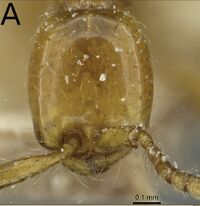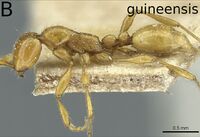Aenictus guineensis
| Aenictus guineensis | |
|---|---|

| |
| Scientific classification | |
| Kingdom: | Animalia |
| Phylum: | Arthropoda |
| Class: | Insecta |
| Order: | Hymenoptera |
| Family: | Formicidae |
| Subfamily: | Dorylinae |
| Genus: | Aenictus |
| Species group: | rotundatus |
| Species complex: | rotundatus |
| Species: | A. guineensis |
| Binomial name | |
| Aenictus guineensis Santschi, 1924 | |
Specimen records show this species has been collected from savanna and cultivated sites. Ants were found foraging under a stone, foraging on the ground and captured in a winkler sample.
Identification
Gómez (2022) - A member of the rotundatus species complex in the Aenictus rotundatus species group. Its sparse, erect, long setae, the presence of a developed subpetiolar process and the lack of a developed propodeal ridge separates this species from the rest of the species present in the rotundatus complex, except for Aenictus ugaduwensis and Aenictus rotundatus, and separation is feasible only via index analysis. It is more slender and presents more rectangular heads than Aenictus ugaduwensis (details under that species).
Aenictus guineensis is the western counterpart of the Southern and Eastern African A. rotundatus, and separating individuals can be difficult, especially with small, isolated individuals.
There are some characteristics that may separate series of workers, but it’s a matter of comparison and very variable among individuals. Some of these for A. guineensis are a more developed propodeal ridge (but as a thin line at most in larger individuals), smoother mandibles (which can become shagreened in the most sculpted A. rotundatus), more rectangular rounded subpetiolar process (against more shark-finned), slightly longer scapes and relatively more elongated petiole.
Keys including this Species
Distribution
Latitudinal Distribution Pattern
Latitudinal Range: 13.37629° to 13.37629°.
| North Temperate |
North Subtropical |
Tropical | South Subtropical |
South Temperate |
- Source: AntMaps
Distribution based on Regional Taxon Lists
Afrotropical Region: Benin, Gambia, Guinea (type locality), Guinea-Bissau, Ivory Coast, Kenya, Nigeria, Senegal.
Distribution based on AntMaps
Distribution based on AntWeb specimens
Check data from AntWeb
Countries Occupied
| Number of countries occupied by this species based on AntWiki Regional Taxon Lists. In general, fewer countries occupied indicates a narrower range, while more countries indicates a more widespread species. |

|
Estimated Abundance
| Relative abundance based on number of AntMaps records per species (this species within the purple bar). Fewer records (to the left) indicates a less abundant/encountered species while more records (to the right) indicates more abundant/encountered species. |

|
Biology
Castes
Known only from the worker caste. Table of castes known for all Afrotropical Aenictus species.
Worker
Nomenclature
The following information is derived from Barry Bolton's Online Catalogue of the Ants of the World.
- guineensis. Aenictus rotundatus st. guineensis Santschi, 1924b: 204, fig. 7b, 7b’ (w.) GUINEA.
- Type-material: syntype workers (number not stated).
- [Note: Baroni Urbani, 1977e: 67, cites 2w syntypes NHMB.]
- Type-locality: Guinea (“Guinée française”): Kakulima (F. Silvestri).
- Type-depository: NHMB.
- [Note: other original syntypes perhaps in the Silvestri collection DEUN.]
- Subspecies of rotundatus: Bolton, 1995b: 59; Hita Garcia, et al. 2013: 201.
- Status as species: Gómez, 2022: 61 (redescription)
- Distribution: Guinea, Ivory Coast, Nigeria, Senegal.
Unless otherwise noted the text for the remainder of this section is reported from the publication that includes the original description.
Taxonomic Notes
Taylor et al. (2018): Type worker CASENT0911438, as Aenictus rotundatus Mayr stirps guineensis n.st., Santschi, 1924; type location Guinea. Additional prior record from Nigeria (Taylor, 1980, as Aenictus sp. 1). This species is some 75-80% of the size of the Eastern Africa species Aenictus rotundatus and has a notably more rectangular head and a flatter profile to the petiole among other differences. New record from Benin: J.-F. VAYSSIÈRES, Korobourou, RVA 3015, 9.xi.2012, M. indica orchard, Quadrat 1, série 1, variété Gouverneur, ground nesting, n = 2.
Description
Worker
Gómez (2022) - HL: 0.63 [0.51-0.76]; HW: 0.54 [0.42-0.67]; SL: 0.45 [0.32-0.55]; WL: 0.98 [0.76-1.19]; PL: 0.24 [0.18-0.28]; PH: 0.17 [0.13- 0.20]; PPL: 0.18 [0.12-0.22]; PPH: 0.16 [0.12-0.21]; CS: 0.59 [0.46-0.71]; CI: 86 [80-90]; SIL: 70 [62-75]; SIW: 81 [77-86]; WL/HW: 179 [172-187]; PI: 137 [129-147]; PPI: 115 [100-128]; CSR: 152; (n=28).
With the characteristics of the rotundatus species complex and: scapes relatively long, almost reaching three quarters of the head (SL/HL~70). Funicular segments slightly longer than wide, the last three engrossing to the apical, which is about twice longer than wide. Head rectangular, longer than wide (CI~86), convex laterally and widest at the middle. Occipital line straight to slightly convex. Ventrolateral margin present, continuing behind the head to one fourth of its length. Mandibles triangular; with a long, sharp apical tooth followed by 5–6 triangular denticles. Clypeus a row of 6–10 conical teeth, clearly visible and longer than wide, decreasing to the sides, sometimes eroded. Frontal ridges present, not projecting frontally and not fused between the antennal sockets.
Pronotum convex, smoothly running into the straight mesonotum; mesopropodeal suture present and visible both laterally and dorsally, concave and meeting the propodeum at an angle; this with a very reduced but discernible anterior slope and elevated over the mesonotum; propodeal shape an elongated hexagon dorsally, widest in its anterior third over the propodeal spiracle, its sides often defined by weak rugulae. Transverse mesopleural groove not present. Mesometapleural suture present but very weak; propodeal ridge complete and present, except in the minima workers, where it can be reduced and faint; propodeal declivity concave below that line.
Petiole sessile with anterolateral ridges present, anterodorsal and dorsolateral ridges absent. Petiole ellipsoidal, rounded, anteriorly almost flat at 45 degrees and vertical posteriorly. Postpetiole subrectangular with rounded angles and vertical anterior and posteriorly, the posterior higher and less rounded, without carinae or ridges of any kind. Subpetiolar process developed with a bulky ellipsoidal process, followed by a lamellae variable in size from almost non-existent to about the size of the bulky process, rounded and pointing downwards.
Head, scapes, pronotum, mesonotum, dorsum of petiole and postpetiole, gaster and legs, smooth and shining; mandibles mostly smooth, variable rugulose in its upper half; propodeum, lateropetiole and lateropostpetiole alutaceus to reticulated, matt. Overall colour light brown to brown, slightly lighter at gaster and apex of funiculus.
Decumbent white setae, oriented backwards, present at head, dorsum of pronotum petiole, postpetiole and gaster. Dorsum of propodeum bare except for its posterior border, with 2–4 long erect setae. A few scattered, long, white, erect setae present at pronotum, petiole, postpetiole and gastral tergites, longer than petiole height. Scapes with white unequally long semierect setae, clearly longer than scape width.
Type Material
- Syntype, GUINEA: Kakulima (Silvestri) (1w) [CASENT0911438] NHMB [Examined by Gomez, 2022]; Syntype, same data (1w, beheaded) NHMB [Examined by Gomez, 2022]. The type material [CASENT0911438] presents two labels, as A. rotundatus v. guineensis and as A. guineensis.
References
- Gomez, K. 2022. A revision of the Afrotropical species of the Dorylinae ant genus Aenictus (Hymenoptera: Formicidae) based on the worker caste. Belgian Journal of Entomology 124: 1–86 (doi:10.5281/zenodo.5898821).
- Santschi, F. 1924b. Descriptions de nouveaux Formicides africains et notes diverses. II. Rev. Zool. Afr. (Bruss.) 12: 195-224.
- Taylor, B., Agoinon, N., Sinzogan, A., Adandonon, A., Kouaguou, Y. N., Bello, S., Wargui, R., Anato, F., Ouagoussounon, I., Houngbo, H., Tchibozo, S., Todjihounde, R., Vayssieres, J.F. 2018. Records of ants (Hymenoptera: Formicidae) from the Republic of Benin, with particular reference to the mango farm ecosystem. Journal of Insect Biodiversity 8(1): 6-29 (doi:10.12976/jib/2018.08.1.2).


